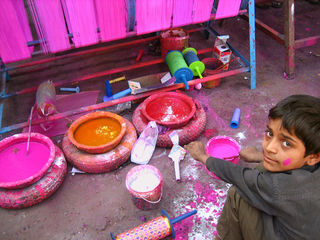

As we watch the dismantling of the EPA here at home, the National Green Tribunal in India, its highest legal environmental authority, has been caught up in kite strings. And it’s a serious business.
Manja (also transliterated as manjha) is the term in India for a special sort of string used in aggressive kite flying. The basis of the string is common thread (cotton or nylon synthetic), but it does not stop there. To make manja designed for competitive kite flying, the string is coated with a mixture of glue and powdered glass. Converted to an efficient slicing instrument, one adept flyer can use his or her kite string to sever the ties that bind any other kite to a nearby opponent. Fans of the novel the Kite Runner may recognize this practice in the “glass string” that Baba would buy for Hassan and Amir, because manja, which goes by many names, is popular in Afghanistan, too. In fact, this practice also has a significant foothold in the Americas, in particular in Brazil. In India, though, manja mania has a definite peak season in the post-winter solstice holiday Makar Sankranti in which kites flying is an integral part of the celebrations.
To say that manja kite flying is a cut-throat avocation is no mere metaphor, unfortunately. Ever year there are multiple cases of extreme close encounters with manja. One recent medical report out of a single hospital in Ahmedabad (Gujarat) tallied up 104 cases over 4 years, with the most common single scenario laceration of the throat among motorcycle drivers. Half way around the world, an entirely different 5-year case count from a hospital in Belo Horizonte, Brazil reached a total of 211 victims (with two motorcycle fatalities). Fatal motorcyclist manja entanglements have been featured in more than one report: a case out of Madras inspired the reporting pathologists to title the article “‘Manja’ – The Killer Thread” (http://www.sciencedirect.com/science/article/pii/0300943277901029).
The National Green Tribunal (or NGT, as it is initialed over there) case was precipitated by suit filed by People for the Ethical Treatment of Animals (PETA (http://www.petaindia.com/media/hearing-petas-plea-national-green-tribunal-passes-interim-order-banning-deadly-manja/) India . They were not arguing that motorcylists are a form of wildlife, but rather that manja, especially nylon based kite string coated with glass (aka Chinese manja), is bad news for birds. There was, of course, an uproar on behalf of business. Manja making is a big deal, at least in the marginal sector of street manufacturing where youths and their elders toil away every day. With rich dyes coloring the glue, it’s all very colorful. Not to mention the potential for little clouds of inhalable silica dust from the making, mixing and application of finely ground glass powder.
The Tribunal agreed that a ban was warranted, at least temporarily until the case could be considered in greater depth. In the U.S., we have no special court equivalent of India’s National Green Tribunal, but we have touted a special relationship between our EPA and India’s Ministry of Environment and Forests. Collaboration has been the special charge of the EPA’s “Office of International and Tribal Affairs” (https://www.epa.gov/international-cooperation/epa-collaboration-india). This office may be as endangered as a motorcycle driver during Makar Sankranti. And if you think Scott Pruitt should go fly a kite, he may agree, as long as he can use a manja cord around his own Agency’s throat.

